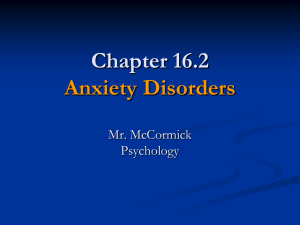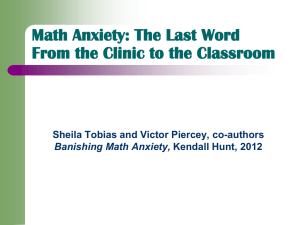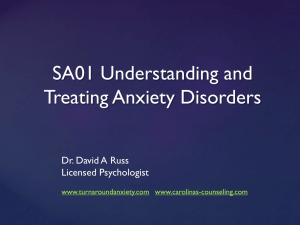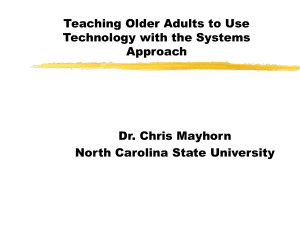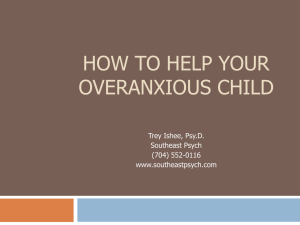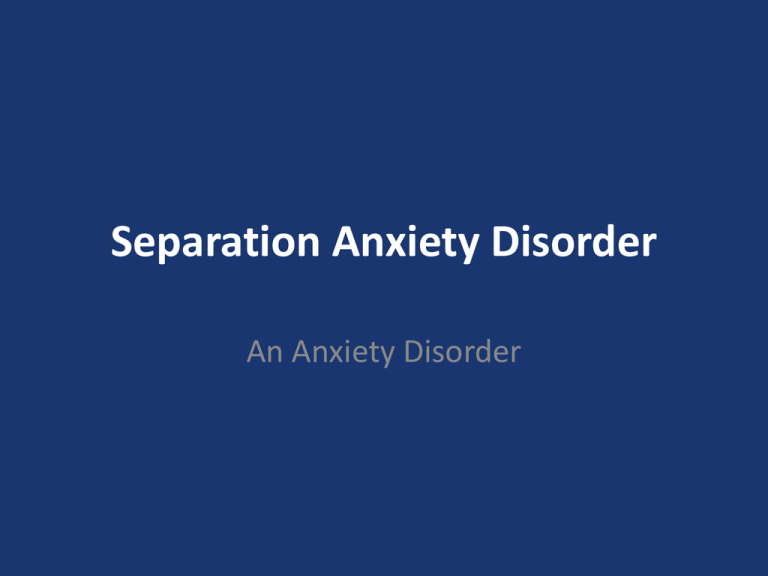
Separation Anxiety Disorder
An Anxiety Disorder
Anxiety Disorders
•
•
•
•
•
•
•
•
•
•
•
Separation Anxiety Disorder
Selective Mutism
Specific Phobia
Social Anxiety Disorder (social phobia)
Panic Disorder
Agoraphobia
Generalized Anxiety Disorder
Substance/Medication-Induced Anxiety Disorder
Anxiety Disorder Due to Another Medical Condition
Other Specified Anxiety Disorder
Unspecified Anxiety Disorder
Anxiety Disorders
• Similarities
• Differences
History of Separation Anxiety
Disorder in the DSM
• Introduced DSM-III, 1980
– 3 of 9 symptoms @ least 2 weeks
– Anxiety Disorders of Childhood
• DSM-III to DSM-IV
– 3 of 8 criteria @ least 4 weeks
– No more Anxiety Disorders of Childhood
• IV to IV-TR
– Prevalence and Course sections were updated
•
IV-TR to DSM-5
–
–
–
–
Anxiety Disorder
Wording
No more specific onset of 18yo
Addition of 6mo or more duration criterion
Separation Anxiety Disorder: DSM-5
A. Developmentally inappropriate and excessive anxiety concerning separation from home or from those to
whom the individual is attached, as evidenced by at least three (or more) of the following:
(1) Recurrent excessive distress when separation from home or major attachment figures
(2) Persistent and excessive worry about losing major attachment figures or about possible harm to them, such as
illness, injury, disasters, or death
(3) Persistent and excessive worry about experiencing an untoward event (e.g., getting lost, being kidnapped,
having an accident, becoming ill)
(4) Persistent reluctance or refusal to go out, away from the home, to school, to work, or elsewhere because of fear
of separation
(5) Persistently and excessive fear of or reluctance about being alone or without major attachment figures at home
or in other settings.
(6) Persistent reluctance or refusal to sleep away from home or to go to sleep without being near a major
attachment figure.
(7) Repeated nightmares involving the theme of separation
(8) Repeated complaints of physical symptoms (e.g., headaches, stomachaches, nausea, vomiting) when separation
from major attachment figures occurs or is anticipated
B. The fear, anxiety, or avoidance is persistent, lasting at least 4 weeks in children and adolescents and typically
6 months or more in adults
C. The disturbance causes clinically significant distress or impairment in social, academic (occupational), or
other important areas of functioning.
D. The disturbance is not better explained by another mental disorder, such as refusing to leave home because
of excessive resistance to change in autism spectrum disorder; delusions or hallucinations concerning
separation in psychotic disorders; refusal to go outside without a trusted companion in agoraphobia; worries
about ill health or other harm befalling significant others in generalized anxiety disorder; or concerns about
having an illness in illness anxiety disorder
Specify if: Early Onset: if onset occurs before age 6 years
Criterion for Separation Anxiety Disorder
A. Developmentally inappropriate and excessive anxiety concerning separation
from home or from those to whom the individual is attached, as evidenced by
at least three (or more) of the following:
(1) Recurrent excessive distress when separation from home or major
attachment figures
(2) Persistent and excessive worry about losing major attachment figures or
about possible harm to them, such as illness, injury, disasters, or death
(3) Persistent and excessive worry about experiencing an untoward event (e.g.,
getting lost, being kidnapped, having an accident, becoming ill)
(4) Persistent reluctance or refusal to go out, away from the home, to school, to
work, or elsewhere because of fear of separation
(5) Persistently and excessive fear of or reluctance about being alone or without
major attachment figures at home or in other settings.
(6) Persistent reluctance or refusal to sleep away from home or to go to sleep
without being near a major attachment figure.
(7) Repeated nightmares involving the theme of separation
(8) Repeated complaints of physical symptoms (e.g., headaches, stomachaches,
nausea, vomiting) when separation from major attachment figures occurs or is
anticipated
Criterion for Major Depressive Disorder
B. The fear, anxiety, or avoidance is persistent, lasting at least 4 weeks in children
and adolescents and typically 6 months or more in adults
C. The disturbance causes clinically significant distress or impairment in social,
academic (occupational), or other important areas of functioning.
D. The disturbance is not better explained by another mental disorder, such as
refusing to leave home because of excessive resistance to change in autism
spectrum disorder; delusions or hallucinations concerning separation in
psychotic disorders; refusal to go outside without a trusted companion in
agoraphobia; worries about ill health or other harm befalling significant others
in generalized anxiety disorder; or concerns about having an illness in illness
anxiety disorder
Specify if: Early Onset: if onset occurs before age 6 years
Prevalence
• Little controlled research on SAD
• Prevalence rate of 2-4 %
• One study did report 2.8% [2.8%, 95% confidence
interval (CI) 2.1-3.8, for current disorder]
• 15-35% prevalence rate in samples of children
with anxiety disorders
• Suggestion that SAD occurs more frequently in
girls but there is very little support
• Prevalence rate does NOT increase with age
Of youth who will develop SAD
90%
75%
Age 10
Age 13
Prevalence rate declines with age
4.50%
4.00%
3.50%
3.00%
2.50%
2.00%
1.50%
1.00%
0.50%
0.00%
9-10yo
11yo
12yo
Development, Onset, Course, Duration
https://www.youtube.com/watch?v=jEkFp0Ux4OQ
Development, Onset, Course, Duration
cont…
• Course is marked by exacerbation and
remission over a period of years
• As many as 30-44% of children with SAD show
evidence of psychological problems that
continue into adult life
• May precede the development of conditions
such as panic disorder and agoraphobia
Associated Features
• Behavioral
–
–
–
–
Social withdrawal
Difficulty concentrating on work or play
Homesick and Uncomfortable
Anger or Aggression
• Emotional
– Apathy
– Sadness
• Physical Symptoms
– Nausea/Vomiting
– Headaches
– Stomaches
Associated Features cont.
• Cognitive
– Evening or dark perceptual experiences
– Fears
•
•
•
•
•
Accidents
Illness
Monsters
Of getting lost
Of being kidnapped
What do children with
Separation Anxiety Disorder look like?
• Frustration
• Resentment
• Conflict
• Demanding
• Intrusive
Difference in expression between
younger and older children
• Younger Children 5-8yo
– More symptoms
– Unrealistic worry
– School refusal
• Older Children 9-12yo
– Excessive distress
• Adolescence
– Somatic complaints
– School refusal more common
Risk of Subsequent Psychopathology
Models of Separation Anxiety
•
•
•
•
•
•
•
Environmental Change
Genetic
Parent-Child Attachment
Developmental Considerations
Cognitive Factors
Behavioral Factors
Stress Factors
Environmental Change
STRESS
Environmental Change
Separation
Anxiety
Disorder
Genetic Influence
History of
panic disorder,
anxiety, or
depression
Predisposition toward
later development of
anxiety disorders
Parent-Child Attachment
…Emotional distance
Behaviors
Developmental Considerations
Between
and
Within
Slower rate of development can foster separation anxiety
Cognitive Factors
Anxiety
&
Irrational
Behaviors
Behavioral Factors
Crying and
= distract
Clinging Behavior attention
away
Nurtures anxiety and fear
Stress Factors
Change
(stress factor)
Feel
uncomfortable
Anxious
Response
Neurobiology of
Separation Anxiety Disorder
• Research done on the neurobiology of SAD has
not been exclusively conducted on SAD.
Literature has included SAD when analyzing all
anxiety disorders in groups of children.
• They amygdala has been one of the most
prominent structures identified as being involved
in anxiety disorders.
• Until more research has been conducted solely
on SAD any conclusions drawn would be an
extrapolation of the findings from the other
anxiety disorders
Accounting for Variance: Genetics
Bolton D, Eley TC, O’Connor TG, et al.
• Twin pair study of 6-6.5yo
• N = 854
• MZ and DZ
Accounting for Variance: Genetics cont.
Accounting for Variance: HPA-Axis
Accounting for Variance: HPA-Axis and
hormonal influences during pregnancy
Maternal endocrine activation during
pregnancy and/or early separation or loss
Lower cortisol levels
Anxiety, learned helplessness, depression
Accounting for Variance: HPA-Axis and
Cognitive Appraisal
• Cognitive processes may trigger the stimulation
of the HPA axis activity
– The interpretation of a situation as being stressful or
not
– Separation anxiety disorder is derived from theories
of anxiety disorders generally, which are
predominately cognitive theories
Accounting for Variance: HPA-Axis and
Cognitive Appraisal and Gender
• The pattern of results from the previous
findings suggests there may be some genderrelated differences with regard to the
cognitive appraisal and anticipation of threat
Accounting for Variance: Family Dynamic
Cronk, N. J., Slutske, W. S., Madden, P. a F., Bucholz, K. K., & Heath, A. C. (2004). Risk for separation anxiety disorder among girls: paternal
absence, socioeconomic disadvantage, and genetic vulnerability. Journal of abnormal psychology, 113(2), 237–47. doi:10.1037/0021843X.113.2.237
• N=1,887
• Female MZ and DZ twin pairs
• Looking across 4 SAD Categories @
– Attachment
– Paternal Absence
– Socioeconomic Disadvantage
4 Categories of SAD
• SAD-Symptoms
– Presence of 3 or more symptoms
• SAD-Cluster
– Presence of 3 or more symptoms occuring together for a
period of at least 1 month
• SAD-Impair
– Presence of 3 or more symptoms causing impairment in
functioning and/or treatment seeking
• SAD-Full
– Presence of 3 or more symptoms with clustering and
impairment/treatment seeking, consistent with DSM-IV
Race
Income
Paternal
Absence
a=additive genetic factor
c=shared environmental factor
p=paternal absence effect
s=socioeconomic disadvantage effect
What this study says…
• Effects of paternal absence on SAD are rather
robust.
• As predicted, paternal absence appears to be an
important predictor of all categories of SAD
– Suggesting that the loss or threat of loss of a father
figure has important consequences for separation
anxiety in girls.
• Attachment theory, suggest that the loss of a
parent (or attachment figure) in the preschool
years or younger would be most detrimental to
subsequent development.
What this means…
• Socioeconomic disadvantage
– 0.1%-1.0% total variance
– 0.4%-2.7% shared environmental effects
• Paternal Absence
– 1.0%-3.0% total variance
– 4.3%-8.7% shared environmental effects
• “Important role for genes”
• High Heritability estimates for parentreported symptoms of SAD in girls
Maddie Marks’ Model
References
Allen, J. L., Lavallee, K. L., Herren, C., Ruhe, K., & Schneider, S. (2010). DSM-IV criteria for childhood
separation anxiety disorder: informant, age, and sex differences. Journal of anxiety disorders,
24(8), 946–52. doi:10.1016/j.janxdis.2010.06.022
Beesdo K, Bittner A, Pine DS, et al. Incidence of social anxiety disorder and the consistent risk for
secondary depression in the first three decades of life. Arch Gen Psychiatry. 2007;64(8):903–
12. [PubMed]
Bittner, A., Egger H.L., Erkanli, A., Costello J.E., Foley D.L., Angold, A. (2007). What do childhood anxiety
disorders predict? Journal of Child Psychology and Psychiatry 2007;48:1174e83.
Bolton D, Eley TC, O’Connor TG, et al. Prevalence and genetic and environmental influences on anxiety
disorders in 6-year-old twins. Psychol Med. 2006;36(3):335–44. [PubMed]
Brückl TM, Wittchen H-U, Höfler M, Pfister H, Schneider S, Lieb R. Childhood separation anxiety and the
risk of subsequent psychopathology: results from a community study. Psychotherapy and
Psychosomatics 2007;76:47e56.
Cronk, N. J., Slutske, W. S., Madden, P. a F., Bucholz, K. K., & Heath, A. C. (2004). Risk for separation
anxiety disorder among girls: paternal absence, socioeconomic disadvantage, and genetic
vulnerability. Journal of abnormal psychology, 113(2), 237–47. doi:10.1037/0021843X.113.2.237Dabkowska, M., Araszkiewicz, A., Dabkowska, A., & Wilkosc, M. (2011). Separation Anxiety in Children
and Adolescents. DIFFERENT VIEWS OF ANXIETY DISORDERS, 313.
References cont.
Goodwin, R., J. D. Lipsitz, T. F. Chapman, S. Mannuzza, and A. J. Fyer. "Obsessive-compulsive Disorder
and Separation Anxiety Co-morbidity in Early Onset Panic Disorder" Psychological Medicine 31,
no. 7 (October 2001): 1307-1310.
Kaplow, J. B., P. J. Curran, A. Angold, E. J. Costello.; "The Prospective Relation between Dimensions of
Anxiety and the Initiation of Adolescent Alcohol Use." Journal of Clinical Child Psychology 30, no.
3 (2001): 316-326.
Kessler RC, Berglund P, Demler O, et al. Lifetime prevalence and age-of-onset distributions of DSM-IV
disorders in the National Comorbidity Survey Replication. Arch Gen Psychiatry.2005;62:593–
602. [PubMed]
Pine DS, Cohen P, Gurley D, et al. The risk for early-adulthood anxiety and depressive disorders in
adolescents with anxiety and depressive disorders. Arch Gen Psychiatry. 1998;55:56–
64.[PubMed]
Weems, C. F., & Carrion, V. G. (2007). Clinical Case Studies. doi:10.1177/1534650103253818
Wittchen HU, Lieb R, Schuster P, et al. When is onset? Investigations into early developmental stages of
anxiety and depressive disorders. In: Rapoport JL, editor. Childhood onset of “adult”
psychopathology. Clinical and research advances.Washington, DC: American Psychiatric Press,
Inc; 1999. pp. 259–302.



